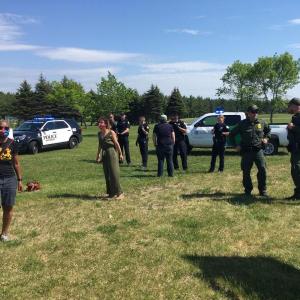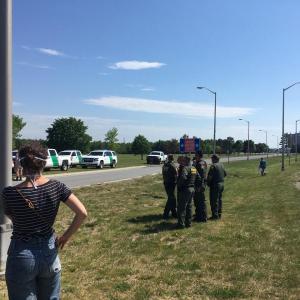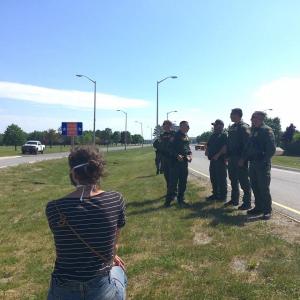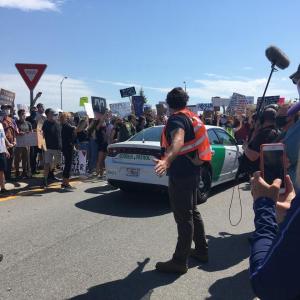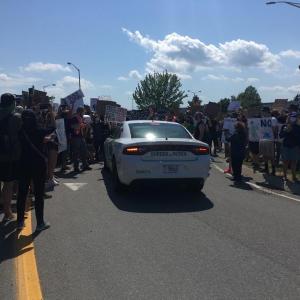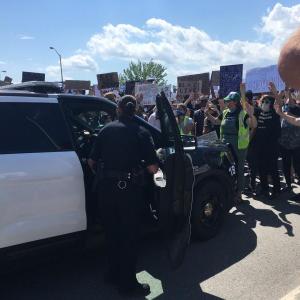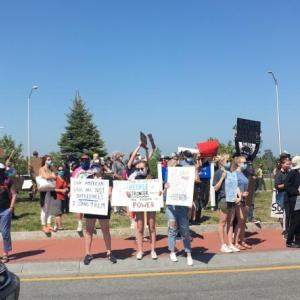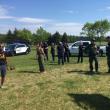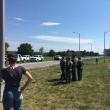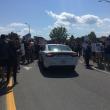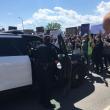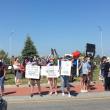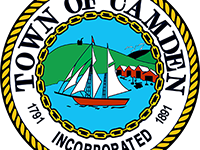Is This What Democracy Looks Like?
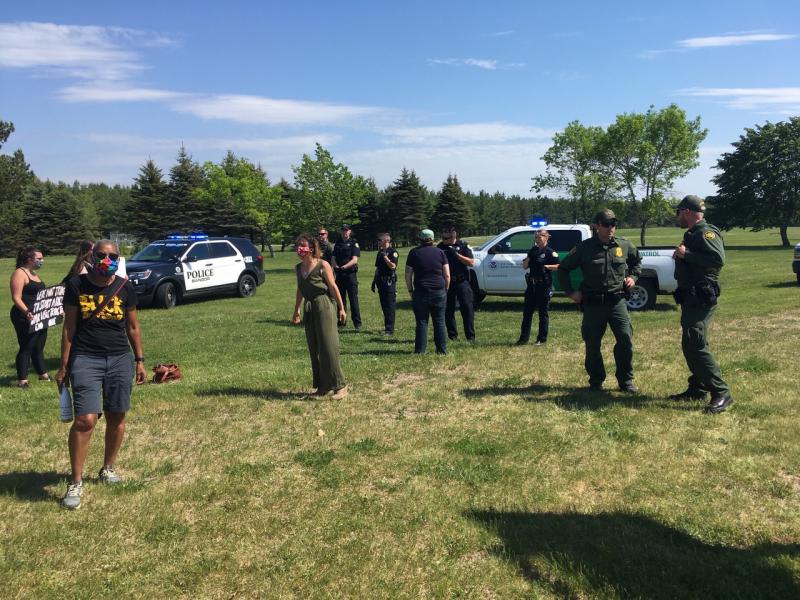 The police set up loosely organized defensive line to stop the protestors from heading to the airport fence. Protestors wore masks against the pandemic; the “safety” officers did not. The green uniforms belong to the border patrol. (Photo courtesy Molly Mulhern)
The police set up loosely organized defensive line to stop the protestors from heading to the airport fence. Protestors wore masks against the pandemic; the “safety” officers did not. The green uniforms belong to the border patrol. (Photo courtesy Molly Mulhern)
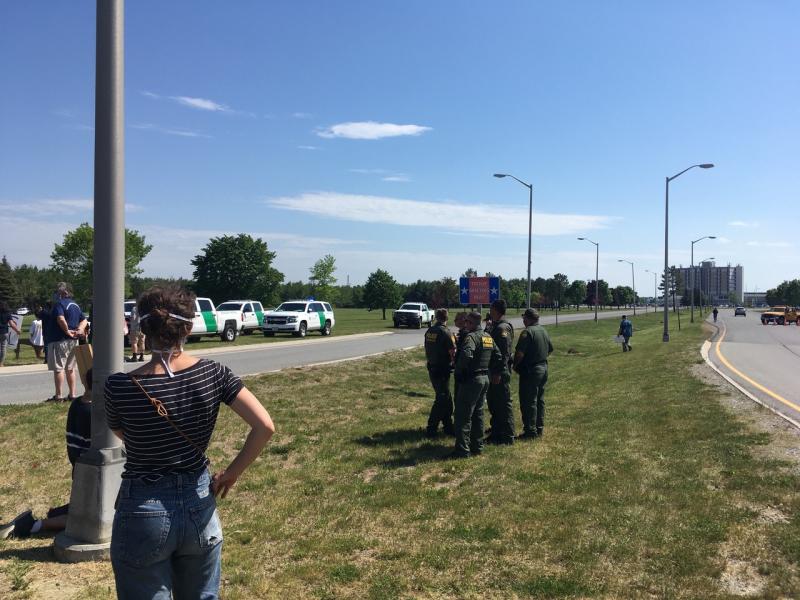 The nonmasked group of border patrol fellows who told me they were there to “keep me safe.” Their vehicles are parked on the left, with the airport fence and Air Force One in the distance beyond. (Photo courtesy Molly Mulhern)
The nonmasked group of border patrol fellows who told me they were there to “keep me safe.” Their vehicles are parked on the left, with the airport fence and Air Force One in the distance beyond. (Photo courtesy Molly Mulhern)
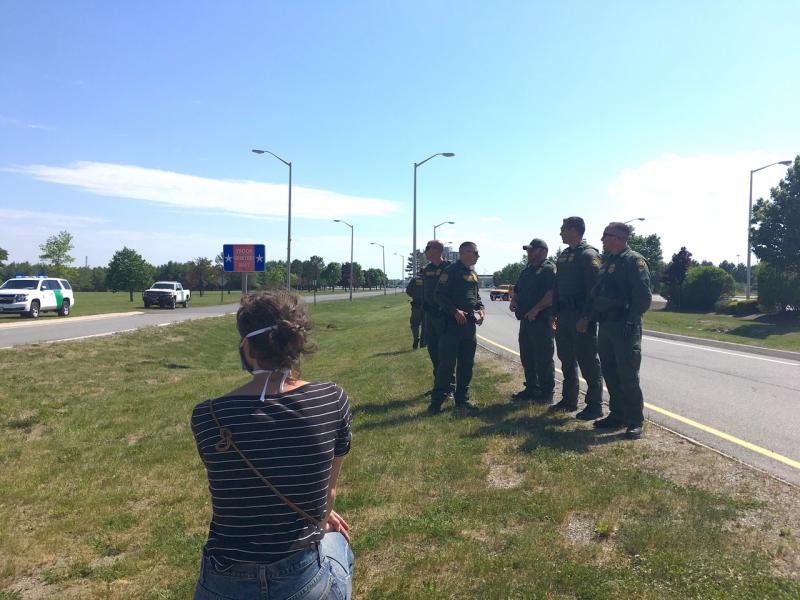 (Photo courtesy Molly Mulhern)
(Photo courtesy Molly Mulhern)
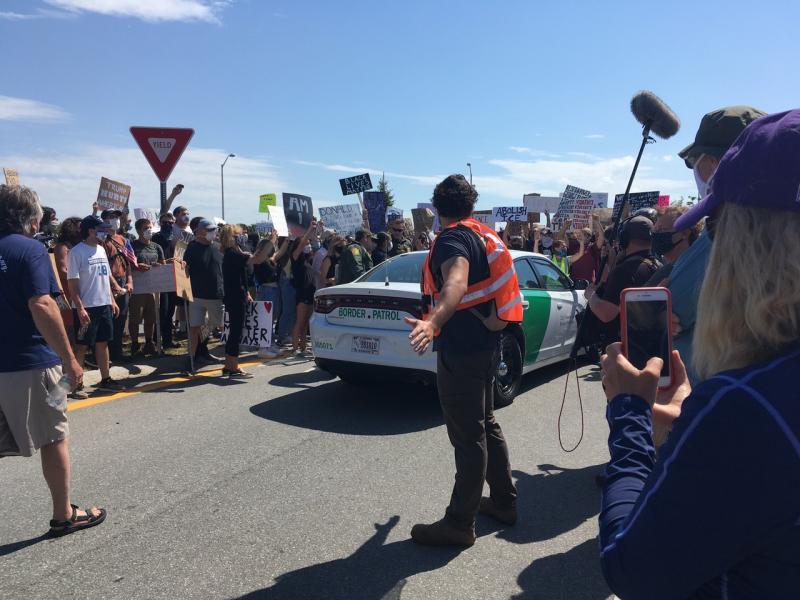 The first car in the border patrol caravan being forced to backup, yielding to the protestors. (Photo courtesy Molly Mulhern)
The first car in the border patrol caravan being forced to backup, yielding to the protestors. (Photo courtesy Molly Mulhern)
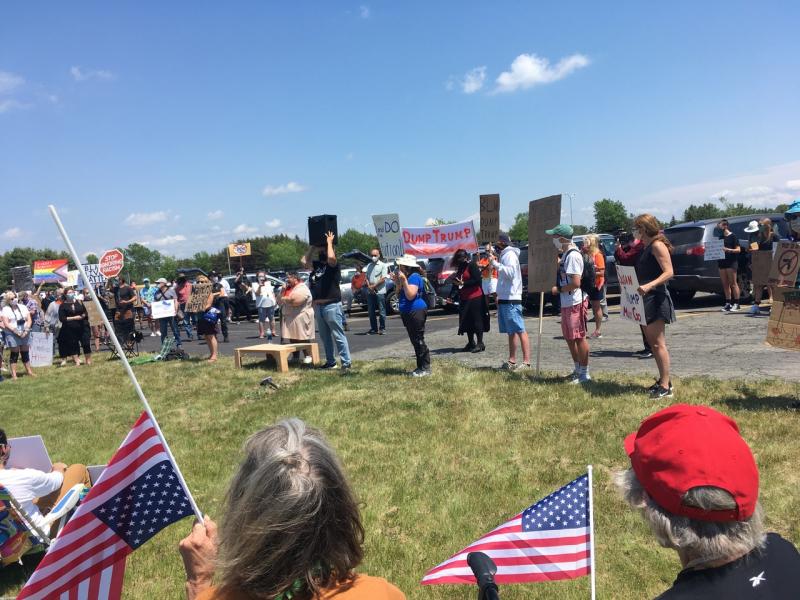 At first the crowd of over 1,000 was content to listen to the speakers. (Photo courtesy Molly Mulhern)
At first the crowd of over 1,000 was content to listen to the speakers. (Photo courtesy Molly Mulhern)
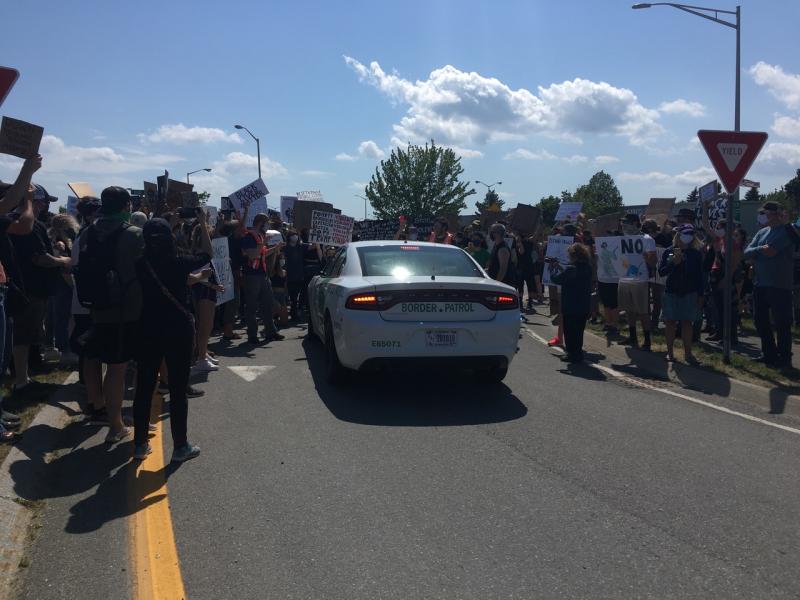 The border patrol’s attempt to drive through the crowd of protestors was met with a wall of humanity. (Photo courtesy Molly Mulhern)
The border patrol’s attempt to drive through the crowd of protestors was met with a wall of humanity. (Photo courtesy Molly Mulhern)
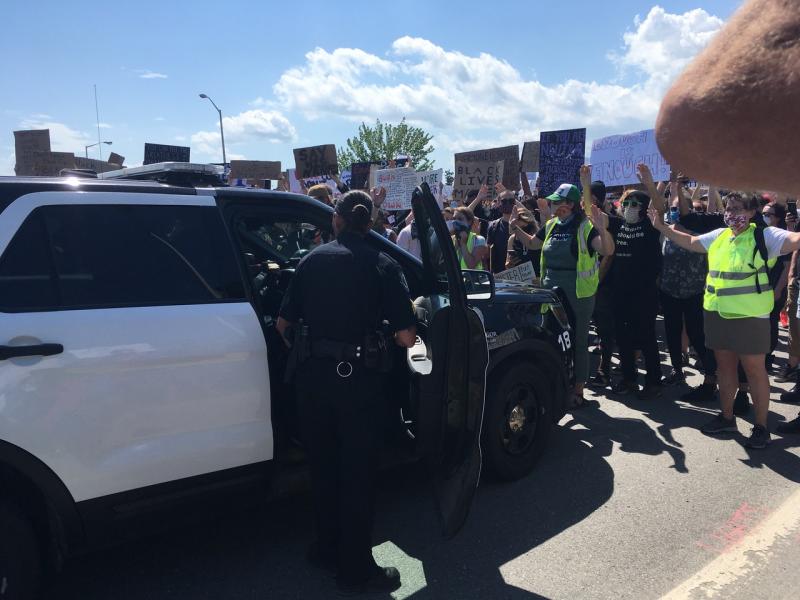 The Bangor police cruiser was met with a wall of protestors, wearing masks. The police officers were not. (Photo courtesy Molly Mulhern)
The Bangor police cruiser was met with a wall of protestors, wearing masks. The police officers were not. (Photo courtesy Molly Mulhern)
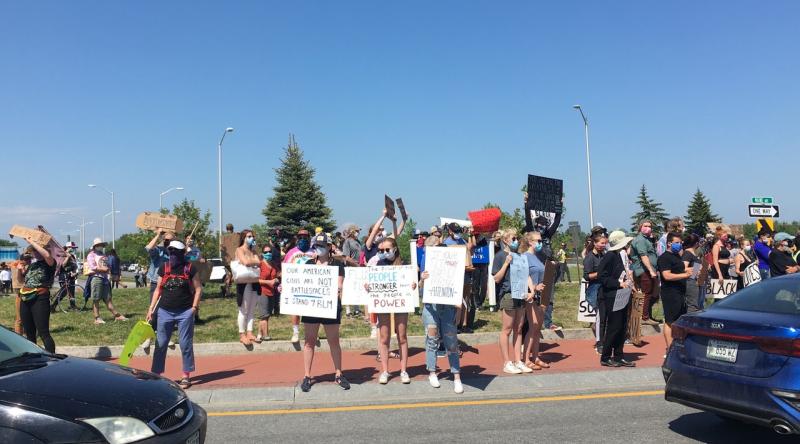 The protest was well attended and spirited, and the signs highly original. (Photo courtesy Molly Mulhern)
The protest was well attended and spirited, and the signs highly original. (Photo courtesy Molly Mulhern)
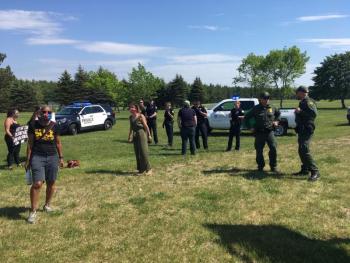 The police set up loosely organized defensive line to stop the protestors from heading to the airport fence. Protestors wore masks against the pandemic; the “safety” officers did not. The green uniforms belong to the border patrol. (Photo courtesy Molly Mulhern)
The police set up loosely organized defensive line to stop the protestors from heading to the airport fence. Protestors wore masks against the pandemic; the “safety” officers did not. The green uniforms belong to the border patrol. (Photo courtesy Molly Mulhern)
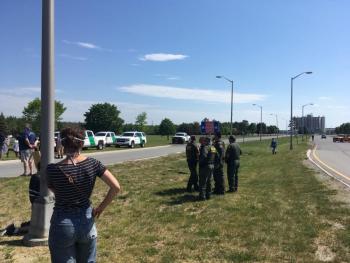 The nonmasked group of border patrol fellows who told me they were there to “keep me safe.” Their vehicles are parked on the left, with the airport fence and Air Force One in the distance beyond. (Photo courtesy Molly Mulhern)
The nonmasked group of border patrol fellows who told me they were there to “keep me safe.” Their vehicles are parked on the left, with the airport fence and Air Force One in the distance beyond. (Photo courtesy Molly Mulhern)
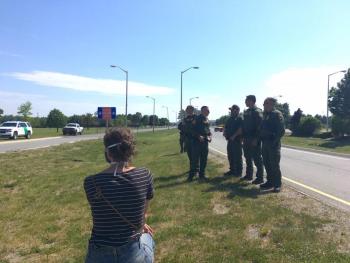 (Photo courtesy Molly Mulhern)
(Photo courtesy Molly Mulhern)
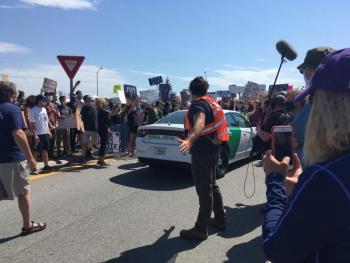 The first car in the border patrol caravan being forced to backup, yielding to the protestors. (Photo courtesy Molly Mulhern)
The first car in the border patrol caravan being forced to backup, yielding to the protestors. (Photo courtesy Molly Mulhern)
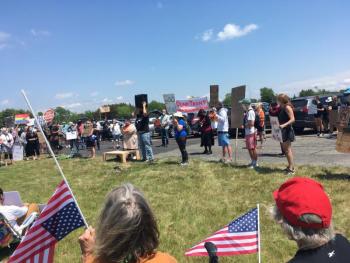 At first the crowd of over 1,000 was content to listen to the speakers. (Photo courtesy Molly Mulhern)
At first the crowd of over 1,000 was content to listen to the speakers. (Photo courtesy Molly Mulhern)
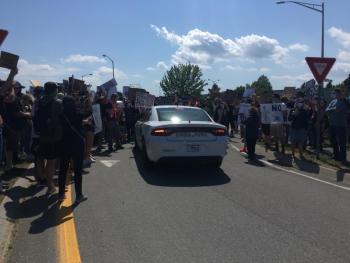 The border patrol’s attempt to drive through the crowd of protestors was met with a wall of humanity. (Photo courtesy Molly Mulhern)
The border patrol’s attempt to drive through the crowd of protestors was met with a wall of humanity. (Photo courtesy Molly Mulhern)
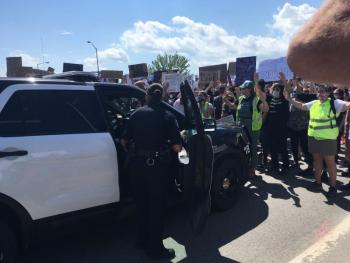 The Bangor police cruiser was met with a wall of protestors, wearing masks. The police officers were not. (Photo courtesy Molly Mulhern)
The Bangor police cruiser was met with a wall of protestors, wearing masks. The police officers were not. (Photo courtesy Molly Mulhern)
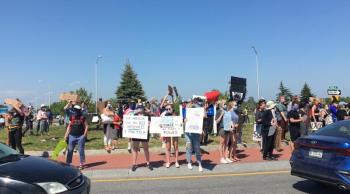 The protest was well attended and spirited, and the signs highly original. (Photo courtesy Molly Mulhern)
The protest was well attended and spirited, and the signs highly original. (Photo courtesy Molly Mulhern)
The folks who organized the protest against the current administration in a huge fenced field near the Bangor Airport on Friday really did have good intentions. And for the first hour and a half, until Air Force One roared in, the masked crowd of over a thousand stood and listened, holding a diverse set of messages, clapping and chanting at appropriate times. The 92-year old woman next to me held a toilet plunger adorned with a “Dump Trump” sign.
We were instructed to turn our backs when the plane flew in. Many of us did just that, others took a knee. Several also shot their middle fingers toward the sky.
After the aircraft landed several speakers went forward to the makeshift platform and grabbed the bullhorn and mic. The crowd in front continued to listen, paying homage to the personal stories—like the father who marched with MLK 60 years earlier, whose vocal son declared his thanks for our attendance—he didn’t want to be marching for the same issues with his son or daughter in another 60 years.
As the black man spoke the back of the crowd slowly marched out of the fenced area toward the airport, a moving river of messages: “Senator Collins is a Bootlicking Coward,” “Donald Trump is a Racist,” “Maine is Not Your Bunker—You Can’t Hide Here.” The organizers quickly took to the mic, urging us not to leave our fenced area to go toward the airport, cautioning that we had no guarantee of safety there. And yet, the crowd moved. It wasn’t safety we were after.
The protest reformed, moved, pulsed—a living, breathing mass, not to be contained behind a fence.
I debated with myself about joining them. But just a little ways off some demonstrators were sneaking under the fence. I jogged over—they held up the chainlink for me, so I dove down, shuffled my prone body across the dirt, stood up, then walked down the road, closer to the sound of Air Force One.
I watched, tried to figure out what was going on. I saw a police SUV stopped in the traffic circle, protesters at its front bumper, their hands held up to the sky. The police officers—not wearing masks, which forced the crowd into chants of “Where’s your mask?”—were milling about their trapped cruiser, one officer raising and lowing the passenger window, holding the SUV’s handheld mic.
I turned my back to that standstill and noticed a stream of 8 -12 white pickup trucks and small cruisers with “U.S. Border Patrol” and a big green swath painted on their sides coming up the road. They passed in one direction, then doubled back moments later, this time with blue lights flashing, driving up to the traffic circle, closing the distance to the stopped police SUV. The protesting crowd stepped into the road, with raised arms, stopping the caravan right in front of me.
I motioned to the non-masked border patrol drivers to roll down their windows. They wouldn’t.
There they sat. There we stood. Some border officers—bored? looking for direction?—got on their phones.
I asked the protestors around me why they thought the border patrol was here. No one seemed to know.
A few green-suited border patrollers got out of their vehicles—not a pandemic mask to be found amongst them. Some border officers spoke to non-masked blue-suited police. Some chatted with yellow-vested, mask-wearing protestors. The protestors blocking the border patrol cars didn’t move.
After a few minutes the border patrol vehicles started backing up. Applause erupted.
“This is what democracy looks like,” we started to chant.
Yet the border patrol wasn’t done with us. They parked their trucks on the grass and reappeared as clumps of standing patrollers at the front of the crowd, part of a physical buffer created by a rather large group of police—20-30, some in riot gear holding large batons—between we protestors and the distant airport fence.
By this time my curiosity had gotten the better of me.
“Why are you here?” I asked a border patrol officer at the edge of the crowd.
“I don’t know, ma’am.”
“Can’t you ask your supervisor?”
“I don’t know, ma’am.”
Not satisfied, I walked over to another group of border patrol officers on a nearby traffic island.
“Why are you here?”
“To help keep you safe.”
“Why do you have guns?”
“It’s part of our uniform.”
“Can’t you do your job without guns?”
“Ma’am I’ve been shot at.”
“Guns don’t keep us safe. Talking to one another keeps us safe.”
Silence.
As I walked away I pondered the show of “force.” Here in a pandemic the ones paid to keep us “safe” were carrying lethal weapons and not wearing masks. Whose idea of safety do we believe? Power over is not safety. Power over is force. Guns are not what keep us safe. Caring for one another, listening to one another, keeps us safe.
I work for a group that helps people extract themselves from unhealthy and dangerous intimate partner situations. We work on safety planning with our clients—making financial plans so they can live autonomous lives; helping them create a community of support—friends and family—to whom they can speak and seek resources. Our work doesn’t involve issuing them guns and training them at a shooting range.
Showing up with your gun does not make me feel safe. A paternalistic world uses guns for safety: “I’ll protect you and keep you safe, my little one, no need to worry.”
You will keep me safe, that is, until you don’t like what I have to say, or when you don’t like some action I have taken, like standing up for myself. Then you will unleash your force, “to keep me safe.” Let’s finally be honest and admit that the gun is to keep you safe. The gun keeps you from having to give up your power. You use guns to keep your power over, to keep up your oppressions. And when it’s not a gun you use, it’s your economic force—by firing me, or not renting to me, or a thousand other tactics of economic oppression.
And as I walked away I also wondered whose idea it was to send federal border patrol agents to a city hundreds of miles from the border, a city that already has an ample police force. Why are my federal tax dollars paying for this unnecessary show of force? Why does our governor or our legislators let border patrol officers show up wherever they feel like it? This is not what a democracy looks like. This is what an authoritarian government looks like.
Molly Mulhern lives in Camden
Event Date
Address
United States

